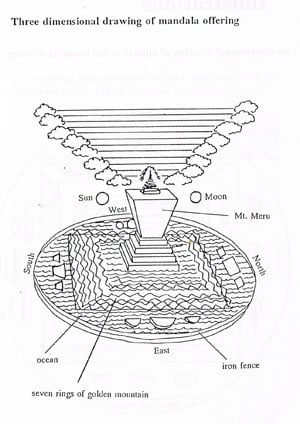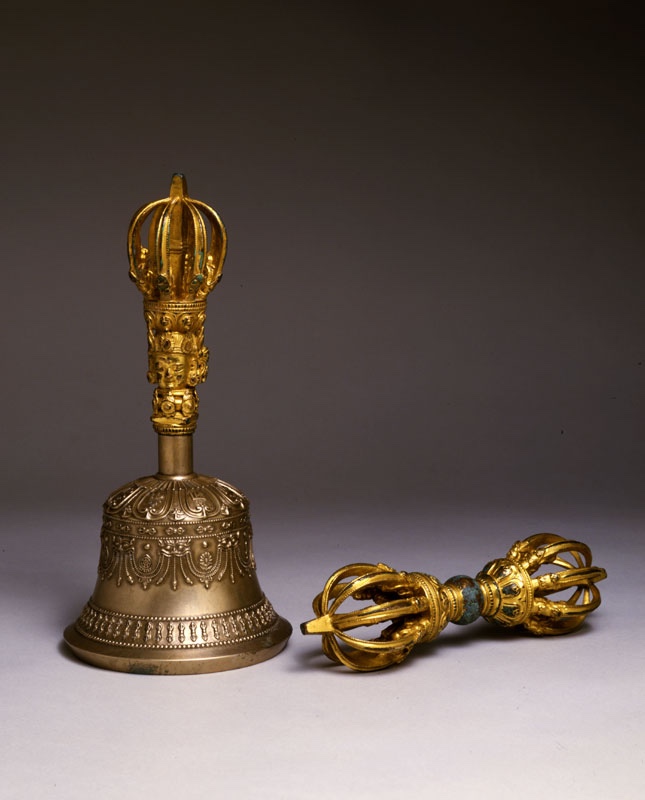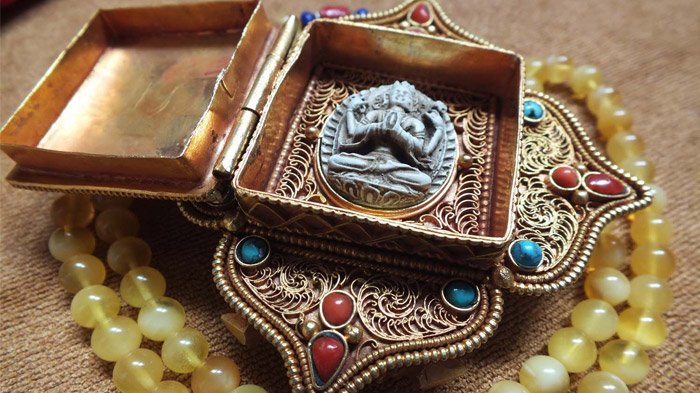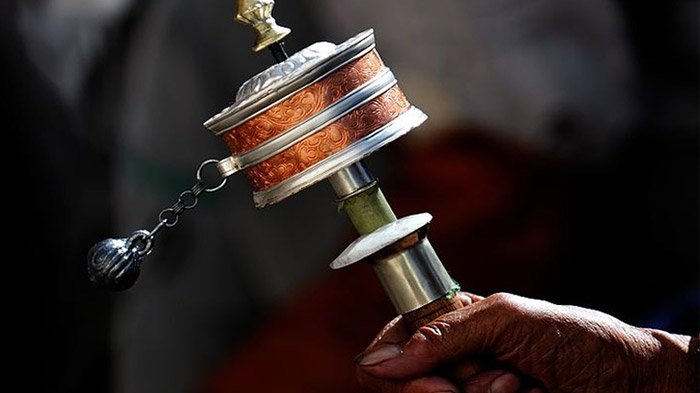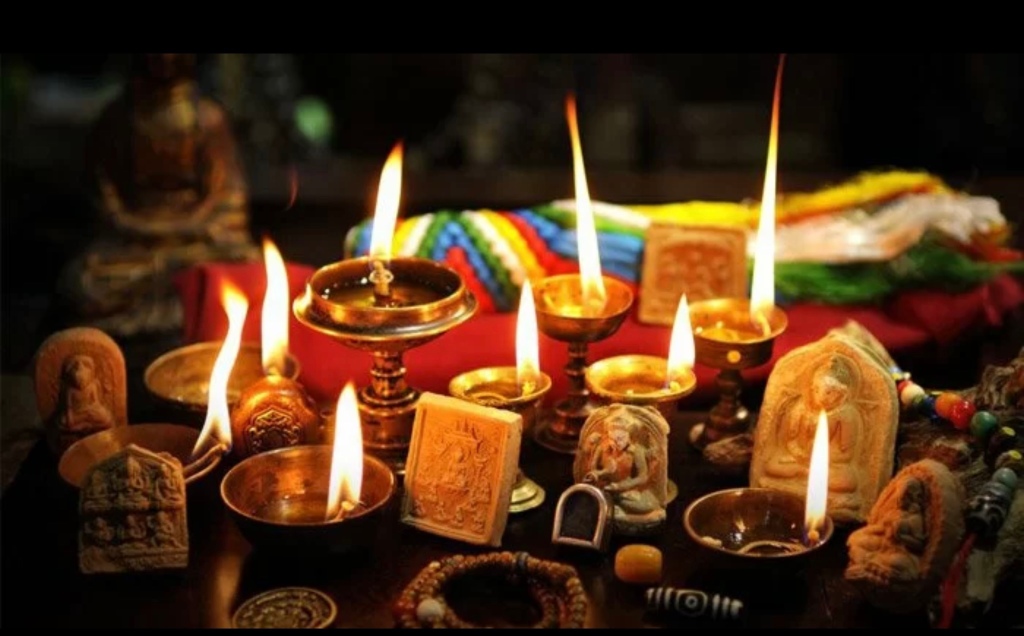How to Offer a Mandala
By Kyabje Lama Zopa Rinpoche
Kopan Monastery, Tushita Meditation Centre and Bodhgaya
A compilation of teachings given by Kyabje Lama Zopa Rinpoche at Kopan Monastery, Tushita Meditation Centre and Bodhgaya in the 1970s and ’80s. With additional material from Kirti Tsenshab Rinpoche, Gen Jampa Wangdu and the Sharpa Choje, Khensur Losang Nyima. Edited by Ven. Thubten Wongmo and Ven. Sangye Khadro.
See also The Wish-Fulfilling Golden Sun of the Mahayana Thought Training and Lama Zopa Rinpoche’s Online Advice Book, for more advice on the mandala offering. Note: Mandala offering sets are available for purchase from FPMT Foundation Store.
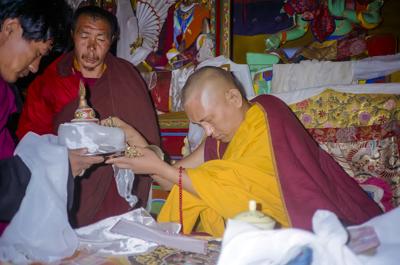
Lama Zopa Rinpoche receiving a mandala offering, 1990. Photo: Merry Colony.
How to Offer a Mandala
The mandala offering is an extremely powerful method for accumulating extensive merit and receiving realizations such as bodhicitta and emptiness quickly. Just as great strength is needed to carry a heavy load, a great amount of merit is needed to lead all sentient beings to enlightenment. There’s nothing that can be offered with your hands that is more meritorious than offering mandalas.
The Tibetan term for mandala is khyil-khor, which means “taking the essence.” The essence you take is the whole path from guru devotion to enlightenment. That’s what you get from doing this practice, plus the result: the unification of dharmakaya and rupakaya. Therefore by doing this practice you receive inconceivable temporal and ultimate happiness.
Mandala Offerings and the Six Perfections
Offering the mandala contains the practice of all six perfections. By cleaning and blessing the mandala base with liquid mixed with a bajung pill you practice the perfection of giving (water symbolizes prosperity). Checking the grain1 for insects and looking after the base, keeping it clean, leads to the perfection of moral conduct. Removing insects from the grain without harming them leads to the perfection of patience. Thinking of how fortunate you are to be able to practice Dharma and making the offering with joy, you cultivate joyous effort. By not forgetting the visualization, you attain concentration. By clearly visualizing the colors and objects in the mandala, and by meditating on its emptiness, wisdom is attained. Therefore offering mandalas helps you to quickly complete the two accumulations of the merits of method and wisdom2 as it contains all six perfections.
This practice pacifies all hindrances to your temporal and ultimate happiness. These depend on merit and merit depends on offerings. The most meritorious object to offer is the mandala. Therefore if you wish to achieve temporal and ultimate happiness, the best thing you can do is to offer many mandalas.
Lama Tsongkhapa offered a million eight hundred thousand mandalas and achieved all the realizations of the stages and paths. If you wish to gain realizations you should offer mandalas to your guru every day as his jewel-like body can bestow the sphere of great bliss in an instant. All realizations depend on your guru. Offering mandalas to him/her is like offering gifts to a king before requesting a favor of him. Achieving enlightenment in one lifetime depends on your relationship with your guru.
Lama Tsongkhapa was instructed by Manjushri to leave the monastery and go to a hermitage where he was to concentrate on bodhicitta, seeing his guru as Buddha, meditate on the path, purify and accumulate merit. Without working on all of these, even if you practice for a hundred years you won’t gain realizations. However, if you do, you will receive realizations within three years or even in a few months. The mere wish to make progress doesn’t make it happen. It’s necessary to create the causes, one of which is accumulating merit.
How to Get the Most Out of Your Practice
Basically, offering the mandala involves mentally offering the entire universe: all the planets and worlds, all sense objects, and especially the objects to which there is much clinging, such as your body, possessions and friends. All these are offered to the merit field. The essential technique of offering is to offer the best quality materials, in the greatest quantity and to have as clear a visualization as possible. In this way you can create extensive merit in just a short time.
Even if you’re a beggar, by making mandala offerings you will receive all the necessities for your practice in this and future lives. By visualizing and then offering whatever you need in the space above the mandala, you create the cause to receive it. Visualizing anything golden and offering it to the buddhas frees you from disease, and offering the moon creates the cause for you to be reborn as a god or a holy being. Offering jewels, gold and enjoyments creates the cause to be reborn in the caste of kings.
If you don’t have good materials you can even use a stone for the mandala base (but first you should ask permission of the spirit landlord, otherwise it’s like stealing). Lama Tsongkhapa’s forearm was blue and bloody with scabs and calluses from making mandala offerings on a stone during his eight-year retreat. This doesn’t mean that lamas don’t have money to buy gold and silver bases. Lama Tsongkhapa did this to emphasize the importance of pure morality. If you are abiding in pure moral conduct you aren’t allowed to touch precious metals with attachment. However, the more valuable the material you offer, the more merit you receive. The best is a gold or silver base, then copper or brass. The finest things to offer are piles of gold, silver, or jewels; next best are sea shells; rice or other grains are acceptable. As mandala offerings are of great consequence, you should offer the finest materials you can afford. If you have enough money to provide yourself with the comforts of life but you use inferior materials for offering, the only result of your offering will be a decrease of merit.
By visualizing the offerings as more precious and extensive, you create vast merits. For example, imagining that you’re offering a Mt. Meru of silver, lapis lazuli, ruby and gold, even if there are no such materials on your base, you receive the merit of actually offering them. So in just a few seconds it’s possible to create the merit of having offered the entire universe. When you offer water bowls it’s good to visualize the water as nectar. The water appears as nectar to the devas, so of course it appears as nectar to the buddhas—this is explained in Maha-anuttara Yoga Tantra. It generates infinite bliss in the holy mind. So if you offer only water, you get the merit of offering water, but if it’s offered as nectar you gain much more merit because of the superior quality of that offering.
The Story of King Ashoka’s Previous Life
Similarly, when making an offering of ten cents to the Buddha, if you clearly visualize the sky filled with dollars, you receive that much merit even if you don’t have a single dollar. What’s the reference that shows that by visualizing nectar or gold you receive the merit of actually offering these? Who had that experience? This was explained by Pabongka Rinpoche in his teaching called Giving Liberation In Your Hand, where he tells the story of King Ashoka’s previous life:
Once when Guru Shakyamuni Buddha was going out for alms he passed three boys playing in the sand. One boy wanted to offer a handful of sand to the Buddha, but was not able to reach the Buddha’s alms bowl, so he stood on the shoulders of the other two boys. He visualized that he was offering gold to the Buddha, and so he created the merit of having actually offered gold. By that karma, the boy was born as King Ashoka in a later life and was able to build ten million stupas in one day. He was able to offer lots of service to the Sangha because he had such great wealth and power.
Through this story you can see how karma is expandable and how to practice Dharma. Even if you’re penniless you can create extensive merit. Being born as King Ashoka, experiencing good results in that life and in future lives, all came from visualizing sand as gold. So even by doing small actions, creating small virtues, things that are easy to do, it’s possible to create unbelievable results of happiness and perfections. So all the time you should practice creating even small merits or good karma. If you’re skillful like the boy in the story, so much merit can be accomplished. But it’s difficult if your practice is unskillful.
The karma stories in the lam-rim are quite unbelievable, like people having strange bodies with horns or tails, or the arhat Tse-yi who had gold pouring unceasingly from his hand. This was the result of his having put a piece of gold in the vase of Buddha Kashyapa in his past life. Shakyamuni Buddha could explain the precise cause of each occurrence. For example, he could tell the causes of new diseases that appear in the world.
The lam-rim teachings on karma show us that we shouldn’t ignore even small karmas, because such incredible results can come, things we can’t even imagine. This is the experience of people in the past. We’re not able to remember our experiences through our own mental power, but if there is happiness, it came from virtue. If a person continually makes offerings of water bowls and mandalas, after a few years that person will have better materials to offer. The result is experienced in this life because any merit accumulated with the guru-buddha is very powerful. The same is true for good karma created with a bodhisattva or parents: the result will be experienced in this life.
So if you remember this story you’ll have faith. Even by offering one tiny grain to the Buddha creates so much merit, because karma is expandable. But if we don’t visualize as explained in the prayer, then it’s just offering grain, or maybe offering nothing! You’d just be playing with grains!
The sutras and tantras can be related to for reference. Accumulating merit by offering the mandala and other offerings to the Buddha is the completely reliable method to create causes of happiness, perfections and wealth. Sometimes when money is invested with the expectation of making millions of dollars profit, lots of money may be lost instead. Material values are always going up and down in the world, so you can’t always be sure of making a profit. But the results of creating merit with the Buddha don’t fluctuate. The results will always be sure, provided the merit is dedicated and isn’t destroyed by anger.
For example, there are eight benefits of folding your hands to the Buddha, even if it is not done with a virtuous motive or even if it’s done with anger. The eight benefits are:
1. Having a healthy, attractive body
2. Having pleasant surroundings, servants, etc
3. Being able to keep pure moral conduct
4. Having devotion
5. Having courage to fight delusions and work for others
6. Rebirth as a human or a god
7. Attaining the arya paths
8. Attaining enlightenment
There are also specific benefits of making prostrations. For example, for each atom of ground covered by the body during prostrations we create the merit to be born a chakravartin king a thousand times. These kings are usually bodhisattvas. His Holiness the Dalai Lama is the copper chakravartin king. They have great power to guide sentient beings (one needs power and wealth to be able to guide beings).
So the result of Dharma practice is always there, if it has been dedicated. It’s just a matter of time when the result will be experienced. If there are no interferences, it will be experienced soon. It’s completely reliable; there’s no betrayal regarding the result.
The Importance Of Clear Visualization
Generating lam-rim realizations in the mind quickly depends on creating extensive merit. However much merit can be created in one day, in one hour makes it that much quicker to attain realizations of the lam-rim. Creating merit depends on how clearly and extensively you can visualize. That is the key; that is the essential thing about mandala offerings. In the Lam-rim Chen-mo, Lama Tsongkhapa did not explain mandalas in detail, but he explained the importance of offering the mandala with a clear visualization. This is incredibly important advice. If the visualization is not clear, less merit is created. That’s the secret of mandalas; the amount of merit created depends on clearly visualizing the worlds, etc., as explained in the prayer.
The number of mandalas that are done isn’t so important. The goal is lam-rim realizations, and quick realization depends on clear visualization. You would create more merit by doing ten mandalas with clear visualization than a hundred vaguely visualized. The prayer can be said quickly, but it wouldn’t have so much meaning if done in that way.
It’s not enough to have mere intellectual knowledge of the path—that doesn’t change the mind. If there are seeds, but no soil, water, fertilizer and warmth they won’t grow. Similarly, in order for realizations to grow, for the mind to be transformed by the teachings, you need to purify obstacles and accumulate merit. Offering the mandala is one of the most important methods to accumulate this much-needed merit.
Multiplying the Offering
You can also increase the merit of the offering by imagining that you’re offering many universes, as many as you can imagine. After constructing the mandala, imagine beams of light going out in all directions from the mandala. On the end of each beam is another mandala. Then from each of these mandalas emanate beams of light with a mandala on the end of each, and so on. Another way of multiplying the mandala is to imagine another whole universe on each atom of the first mandala, and then another universe on each of those universes’ atoms, etc. You can also imagine a duplicate image of yourself making a mandala offering in each atom of space. The entire space becomes filled with mandalas.
Although the mandala base is small, you must imagine everything in the universe on it. It’s like seeing many objects reflected in a tiny water bubble, or looking at a mountain through the eye of a needle, or looking at a city from an airplane. It’s very important to think that all these objects actually exist. The imagined symbol of the universe does exist as a creation of the mind.
Between Sessions
Whenever your mind feels solid and unmoving and everything seems to be at a standstill, you should make mandala offerings and strong requests to the guru and the merit field. When you feel like this, heresy towards the teachings can arise and instead of gaining energy to practice and increase your wisdom, you create nothing but downfalls. Offering mandalas will prevent this.
Mandala Offering in Tantra
One of the commitments of Maha-anuttara Yoga Tantra is to offer mandalas six times a day to your guru. This is done during the six-session guru yoga practice. If you don’t have a plate, you can just visualize offering the mandala three times a day and three times at night. If you fail to do this, it’s one bombo (transgression of a branch tantric vow). Kyabje Pabongka Rinpoche said in the lam-rim that breaking a bodhisattva vow is a hundred thousand times heavier than breaking a root vow of a fully ordained monk, and breaking a branch tantric vow is a million times heavier than breaking a root bodhisattva vow. The karmic consequence of breaking a branch tantric vow is the same as that of killing dakinis. However, if you visualize offering the mandala as described in the six-session prayer you don’t receive this fault. It is necessary to recite the six-session prayer to be conscious of what you should practice.
Even those who have achieved the developing stage of tantra have to offer mandalas. If you don’t continuously make mandala offerings from the time you receive a tantric initiation until you achieve the completion stage, there is a great danger to your life from such things as spirits.
The more you understand karma, the more you will recognize the preciousness of this simple practice. The benefits of making one mandala offering are incredible. The disadvantages of not doing so are also very heavy. Kadampa geshes would always carry with them their mandala plates, offering bowls and yellow robes.
By offering mandalas it’s possible to have visions of deities. One fully-ordained nun saw Chenrezig after making many mandala offerings.
NOTES
1 Uncooked grains such as rice or barley can be used as the substance for the mandala offering. [Return to text]
2 In order to attain enlightenment with its two holy bodies (kayas): form body (rupakaya) and truth body (dharmakaya), it is necessary to complete the two accumulations of the merits of method and transcendental wisdom.
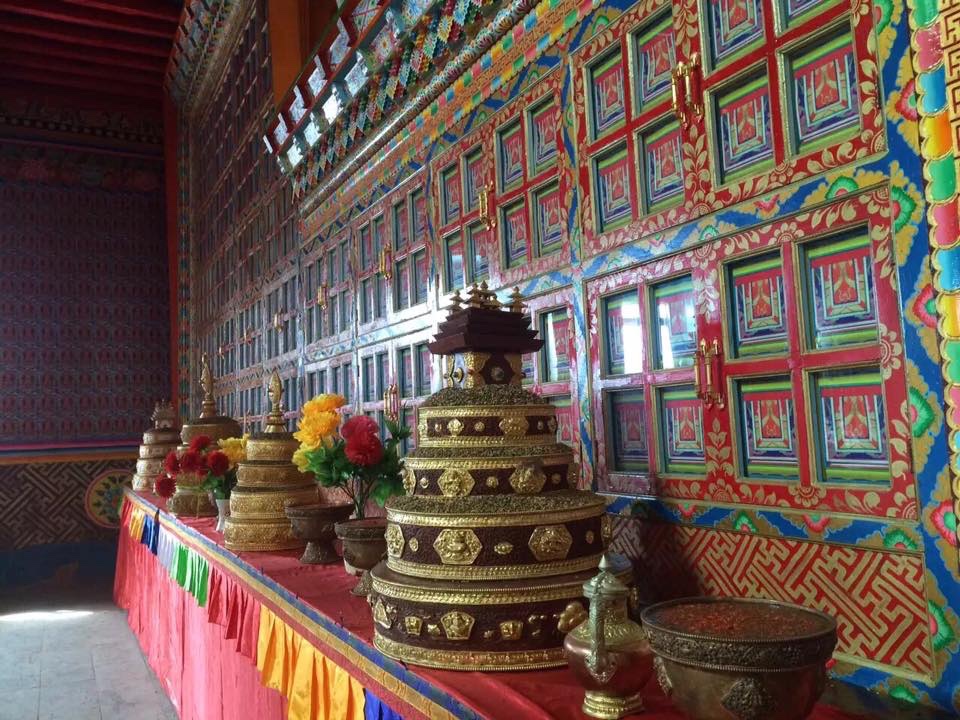
The Actual Practice
If you’re using grain such as rice, it should first be cleaned (insects and dirt removed, washed in water and dried) and made nice-smelling with perfume or scented water. The base should also be cleaned the first time with water to which saffron, scent and a bajung3 pill have been added. This is similar to sprinkling scented water on the ground before inviting a king or guru to the place.
OM VAJRA BHUMI AH HUM—the powerful golden ground. This is recited to bless the mandala. Hold a small amount of grain in each hand. Holding the mandala base with your left hand, pour some grain on the base with your right. This grain symbolizes the negativities and obscurations of yourself and all sentient beings. Tip the base away from you so that the grain spills off and rub the base three times in a clockwise direction with your right wrist.4 Here there is the “bodhicitta vein” associated with the development of clairvoyance. Think that you’re wiping away all the negativities of yourself and all beings. The first wipe eliminates those of body, the second of speech and the third of mind. Think that you’re also eliminating all undesirable places such as the hells and undesirable things such as thorns, illness, misfortunes, the two obscurations and all the impurities of yourself and others that have arisen due to clinging to external objects and the internal mind.
The mandala base becomes the golden ground, representing our buddha nature, with plains as smooth as the palm of a child’s hand. Now place more grain on the base. Tipping it towards you, rub it with your wrist three times counter-clockwise. Think that you’re receiving the qualities, blessings and attainments of the guru and the merit field; these enter your body, speech and mind. You transform into the merit field, or your yidam.
OM VAJRA REKHI AH HUM—encircled by an iron fence. Place some grain in the center of the base and then place the first ring. Never put the ring on an empty base as that would create the karma to take rebirth in a place where a buddha has not descended. After placing the first ring, pour a handful of grain around the edge of the plate, just inside of the ring, moving in a counter-clockwise direction.
Now you begin to place heaps of rice to represent the different objects. There are different ways of constructing the mandala—37 heaps, 25 heaps, 23 heaps and 7 heaps, but here it’s according to the 37-heap method. When you place the heaps, think that the grain is the object. Instead of thinking that the objects drop onto the base with the grain, visualize that they appear out of emptiness, lighting up in space like a light bulb when it’s been turned on. Clear visualization and clear recognition of each object of the mandala is extremely important if you wish to quickly complete the accumulation of merit.
Don’t rush; go slowly and spend time on the visualization to make it as clear as possible. Visualizing each object in turn, think, “I’m offering this to my guru who is the merit field.” Then even if your visualization becomes unclear or gets lost you still create merit. Try to remember the qualities and functions of each object as you name it. This is very beneficial for the mind.
After offering each object, dedicate the merit to all sentient beings.
(The large objects like Mt. Meru you can offer at the end altogether rather than each time.)
The arrangement of the objects offered depends on the purpose of making the offering. In order to request realizations, the east is placed towards you, but in order to make an offering to the merit field, east is on the opposite side, towards the merit field.5
Objects Offered in the Mandala of 37 Heaps
1. Mt. Meru: Place a heap of grain in the center of the base to represent Mt. Meru, which has four faces, each of a different precious substance:
- The eastern face is made of radiant, silvery crystal.
- The southern face is of bright blue lapis lazuli.
- The western face is of ruby.
- The northern face is of gold.
Each jeweled face of Mt. Meru radiates dazzlingly, and its reflection accounts for the color of the sea, sky and world on its respective side.
The top of Mt. Meru is flat and square, like a plateau. Here are found the four guardian kings, and the palace of the worldly gods, who have incredible enjoyments.
The shape of the mountain resembles an inverted pyramid with the apex buried beneath its lower levels. There are eight lower levels which are like eight steps all around the bottom of the mountain. Only four of these are above the ocean, visible to the eye, while the other four are beneath the ocean. The asura realm is located where the water meets Mt. Meru. The sura realms are located on the upper four levels or steps. Here they have enjoyments a hundred times greater than those found in America! Above the fourth level is the god realm, Tushita.
2. The Eastern World: It is white and semi-circular like a half-moon. The people who live there are tall and very beautiful with half-moon-shaped faces. They have subdued minds and limitless possessions. They always enjoy a high status and live for three hundred years. They eat rice and vegetables. They are a quiet, peaceful people who never fight, but they have no religion.
3. The Southern World (this is our world): It is blue and trapezoidal (similar to the canopy of an Indian rickshaw). The inhabitants’ faces are the same shape as their world, as is true of all the worlds. Here, many people have high realizations.
4. The Western World: It is red and circular. The people here have round faces, live for five hundred years and have infinite enjoyments.
5. The Northern World: It is yellow and square. The people here have square faces and beautiful bodies made of light. They live for a thousand years. The standard of life is god-like: there is no fighting, food grows in abundance; the moment one is born one receives everything one needs. Because there is very little suffering there is no desire for religion and the people are unaware of death. But seven days before they die, they hear a voice whispering, telling them where they will be reborn and what sufferings they will experience.
There are not many examples of suffering in the western, northern and eastern worlds, so it is very difficult for those people to practice Dharma.
6-13. Each world has two smaller, similarly-shaped and colored worlds on either side of it. These are the next eight heaps of grain on the base. First put a heap to the left of the main world, then one to the right (i.e. for the eastern world, put the first heap in the south-east and the second in the north-east, then move on to the southern world.)
The next four objects are called the four “precious things.” They are the particular enjoyments of each of the four worlds; things that the inhabitants of each world enjoy the most. We should visualize them in the aspect of offerings, but think that in essence they are realizations of the Dharma. They are to be visualized floating in the sky above their respective world.
14. The Precious Mountain (east): This is a huge mountain made of the seven precious gems: gold, silver, lapis, coral, diamonds, pearls and emeralds.
15. The Wish-Granting Tree (south): It is huge and made of the seven precious gems: its roots are gold, trunk is silver, branches are lapis lazuli, leaves are emeralds, with sapphire buds, pearl flowers and diamond fruit. Thinking of whatever you wish for and praying to the tree, your needs pour down from it like rain. This is by the power of the object. When its leaves rustle, they make the sound of Dharma. The people of the southern world like fruit, so this tree is their particular enjoyment.
16. The Wish-Fulfilling Cow(west): This cow is also made of jewels: with diamond horns, sapphire hooves and a tail like the wish-granting tree. Its body is golden-orangish colored, healthy and very beautiful. Its excrement is gold. Whatever one desires springs forth from its pores. It also gives unceasing milk.
17. The Uncultivated Harvest (north): These are crops that grow unceasingly, without needing to be cultivated. Its fruit is perfect: skinless and clean, easy to pick (just falls off in one’s hand), beautiful and delicious, satisfying all desires.
(If using four rings, place the second ring at this point. If using three rings, the second ring is placed later.)
The next seven objects are the seven possessions of a chakravartin (wheel-turning) or universal monarch; offering them creates the cause to become such a monarch. The qualities of these objects are explained in the Heruka Lama Chöpa.6
18. The Precious Wheel (east): This is a vehicle for the universal monarch, actualized by and propelled by his great stock of merit. It travels very fast—it can cover the four worlds and the god realms in a day—and can carry the monarch and his entire retinue to any part of the universe he wishes to go to.
Made of gold, with a thousand spokes, it’s very bright, like the sun. The wheel is symbolic, when offering it, dedicate: “By offering this precious wheel, may I and all sentient beings achieve complete control over Dharma activities (like Guru Shakyamuni Buddha and His Holiness the Dalai Lama). By understanding the different levels and so on of sentient beings and teaching them accordingly, may I lead all of them to enlightenment.”
Guru Shakyamuni Buddha, by understanding different beings’ capabilities, intelligence, merit, etc., can show various methods without error, and not only through his speech but also in various manifestations. He possesses all realizations of the words and their meanings. So by offering the precious wheel we pray to be able to do the same. This is the benefit of offering this wheel.
19. The Precious Jewel (south): This is an eight-sided wish-fulfilling jewel made of lapis lazuli. It is as bright as the sun, can make night like day-time, and emits light rays of five colors that can be seen for thousands of miles. These rays bring all success and whatever is needed by sentient beings. When we’re tormented by heat they make us feel cool; when it’s cold they provide warmth. They bring all happiness and prevent illness and untimely death to all those within their range. They also fulfill whatever Dharma wishes sentient beings have.
Dedicate: “By offering this precious jewel, may all sentient beings have their Dharma wishes fulfilled perfectly.”
20. The Precious Queen (west): She is extremely beautiful, charming, has a camphor-scented body and sweet-smelling upali-flowered breath. Perfectly dressed, she has a calm, subdued mind and gives good vibrations. She is free of the five faults of women: greed or miserliness with men and other objects, jealousy, anger and pride; and possesses the eight qualities of a perfect lady: harmonious mind, bearing only sons, of noble birth, of high caste, free of jealousy towards other women, does not gossip or hold wrong views, and remains unaffected by objects of the senses. She bestows bliss and freedom from hunger and thirst on any being who touches her. Her mind is endowed with love and compassion; she grants all success and guides all beings from physical and mental suffering.
Dedicate: “By offering this precious queen, may all sentient beings enjoy the non-contaminated, non-deluded great bliss of aryas.”
21. The Precious Minister (north): He has renounced all non-Dharma actions, so all his projects are Dharma-related and for the benefit of others. He is never treacherous or harmful, but always acts with love. He never gets upset about or tired of working for others. He spontaneously carries out the wishes of the universal monarch without having to be asked (he is able to read the monarch’s mind). He is extremely wise and skillful in all situations and in directing the activities of the entourage and the army.
Dedicate: “By offering this precious minister may all sentient beings fulfill exactly all the wishes of the buddhas.”
22. The Precious Elephant (south-east): He is as large and as white as a snow mountain and as strong as a thousand ordinary elephants. He is so wise, skillful and alert that he doesn’t need to be led by a rope; a fine thread is enough. He is decorated like a ceremonial elephant. He has a large penis, and his trunk, tail and testicles touch the ground. He carries the universal monarch wherever he wants to go without needing to be ordered—he can read his master’s mind. He can travel around the universe three times in a day, without shaking or disturbing the rider’s body. He is peaceful, never violent or harmful to others; perfectly obedient, incredibly wise and able to conquer all opposing forces.
Dedicate: “By offering this precious elephant may all sentient beings ride the supreme great vehicle to enlightenment.”
23. The Precious and Excellent Horse (south-west): Is white, of perfect shape, size and color, is decorated with the jeweled crown of the devas, a jeweled saddle and various jeweled ornaments. He can travel around the universe three times in one day, and never gets tired or sick. He is very wise and subdued and can be led by a thread; a bridle is not necessary. He is magnificent-looking, and protects his rider from harm.
Dedicate: “By offering this precious, excellent horse, may all sentient beings attain mundane and supra-mundane psychic powers.” (Offering the precious horse creates the cause to achieve clairvoyance.)
24. The Precious General (north-west): He never harms others as he has totally abandoned all non-Dharma actions. However he can never be defeated in battle. He intuitively knows the wishes of his ruler, and never tires in his service. He leads large armies of horses, elephants, chariots and foot soldiers. In times of struggle and hardship visualizing the precious general prevents you from being harmed by others (the would-be harmers are subdued) and protects you from poverty.
Dedicate: “By offering the precious general may all sentient beings become holders of the entire collection of teachings.”
According to Lama Tsongkhapa, the precious householder is offered at this time, instead of the precious general, who is included with the precious minister. The precious householder has many possessions and jewels: all sentient beings are pleased to see him.
25. The Great Treasure Vase (north-east): It is made of gold, and decorated with jewels. It has a flat base, large belly and long neck, like a Greek urn. The neck is decorated with cloth from the deva realms, and the vase has a beautiful tree as a stopper. The vase contains various treasures and grants all wishes.
(If using four rings, place the third one at this point. If using three rings, place the second.)
26. The Goddess Of Beauty (east): She is white, she stands in an S-shaped dancing posture with hands on her hips, holding a vajra in each hand. She exhibits her beauty through dancing and moving her body.
27. The Goddess Of Garlands (south): She is yellow-colored and very beautiful. She holds a rosary made of precious vajras with both hands at her breasts; with this she grants initiations to whomever comes before her.
28. The Goddess Of Song (west): She is pink-colored; she plays a lute and sings, offering the music to all beings.
29. The Goddess Of Dance (north): She is multi-colored: her face and feet are white, neck and breasts are pink, hands and hips are blue and her thighs are light yellow. She holds a vajra in each hand, with her right hand on her head and left hand on her left hip.
30. The Goddess Of Flowers (south-east): She is bright yellow; in her left hand she holds a vase containing a vajra and flowers. She scatters the flowers in the air with her right hand.
31. The Goddess Of Incense (south-west): She is white; in her right hand she holds an incense burner at the level of her shoulder. The incense totally satisfies whoever it’s offered to. Her left hand is in the threatening gesture at her left shoulder.
32. The Goddess Of Light (north-west): She is pink and holds a beautiful lamp on her left shoulder with her right hand held over her head. Her left hand is at her heart.
33. The Goddess Of Perfume (north-east): She is rainbow-colored. In her left hand at her heart she holds a conch shell containing a vajra and beautifully scented sandal water. With her right hand she sprinkles this perfume in all directions.
These eight goddesses, visualized in space above the first level of Mt. Meru,7 are the emanations of your own transcendental wisdom of non-dual bliss and emptiness. They should be visualized as young and very beautiful. They have slender waists, enchanting faces with fine blue eyes and red lips. Their bodies are fragrant; they have soft, smooth skin which, when touched energizes great bliss. Any sounds they make are lovely to hear. Visualizing the goddesses as exquisitely beautiful in all respects is for the purpose of transforming desire into the path. Imagine that all space is filled with these goddesses.
(If using four rings, place the fourth at this point. If using three, place the third.)
34. The Sun (south): It’s in the southern sky above the level of Mt. Meru. It’s like a gigantic magnifying glass dispelling darkness (the darkness of sentient beings’ gross and subtle delusions); like a clear lens through which hot rays are focused, and it emits brilliant rays of light. Its shape is that of a disc, with a golden fence around its edge. At its centre, stairs lead to a palace in which the children of the gods are dancing and singing.
Think about the function of the sun; for instance, how it causes crops to ripen.
The sun signifies all wisdoms, all paths: Hinayana, Mahayana and Vajrayana. It signifies the clear light, which results in the dharmakaya. The sun is absolute bodhicitta; it dispels the darkness of ignorance grasping at true existence, the root of samsara.
35. The Moon (north): The moon, in the northern sky, is the same size as the sun and is equal to the sun in brightness. Usually, the sun’s light obscures the moon but in the mandala the light of both pervade the world. The moon is also disc-shaped, with a fence around its edge and a palace at its centre where the children of the gods are singing and dancing. The moon causes samsara to cease; its two edges are the two extremes which it eliminates. The light of the moon has the power to dispel sentient beings’ gross obscurations.
The moon symbolizes method, the methods of the three vehicles; also conventional bodhicitta, whose root is compassion. Its light extinguishes the darkness of the self-cherishing attitude, so that we naturally come to cherish others. The light also prevents us from falling into the blissful state of self-liberation.
The moon and the sun are visualized together because method and wisdom, bodhicitta and emptiness, should be practiced together, simultaneously. From the tantric viewpoint the sun represents the clear light of wisdom and the moon represents the illusory body. Visualize that the light of the sun and moon dispels the darkness of the obscurations and ignorance of all sentient beings. By visualizing like this you create the cause to achieve the entire path, both the method and wisdom aspects, that result in attaining the rupakaya and dharmakaya. The sun and moon are also offerings of light.
36. The Precious Parasol (east):8 Its handle is of lapis lazuli encrusted with jewels and gold. Its thousand spokes are of gold, and it is crowned with an eight-sided sapphire. The canopy is white and has a fringe hanging all around; the ends of the fringe are richly decorated with various jewels, some of which are like magnifying glasses and emit powerful light. There are also strands of pearls hanging from the edge; from the jewels and pearls come a flow of nectar that eliminates the true sufferings and true causes of suffering of all sentient beings. There are small glass vases hanging from the fringe from which nectar pours as an offering to the buddhas. This nectar also quenches the thirst and alleviates the suffering of those beings who suffer from thirst. There are also small bells making very sweet Dharma sounds in praise of the Buddha and teaching sentient beings according to their level.
This parasol is similar to the one that the naga king, Maitri, offered to Lord Buddha. Its essence is all the qualities of the cessations, the abandonment of the two obscurations. The parasol can provide extensive protection from suffering and offering it creates the cause for oneself to become an object of refuge, able to save sentient beings from the heat of samsara.
37. The Banner Of Victory Throughout All Directions (west): It has a jeweled shaft with three pieces of cloth hanging from it. There are innumerable small bells hanging from the banner making pleasant tinkling sounds. The banner is illustrated with different symbols, such as an eight-legged lion and a special kind of fish. Its top is crowned with a half-moon and an eight-sided sapphire.
The essence of the banner is all qualities of all realizations. It symbolizes total victory; by offering it we create the cause to be victorious over the four maras. We also create the cause to be able to benefit others perfectly by leading them according to their level, and to liberate them from the fears and sufferings of samsara. It brings about the auspicious conditions for us to realize the Dharma and thus become a holder of the banner of the teachings, like Vajradhara.
In times of trouble, banners were placed on the roofs of monasteries to overcome negative forces. By putting the banner in the front of the mandala, we create the cause to have perfect listening, reflecting and meditation, and to become a holder of all Dharma teachings.
Now place three heaps in the center, symbolizing the realizations of the body, speech and mind of the merit field; by offering these we create the cause to be able to attain them. Then place the mandala top. With a small amount of grain in both hands, hold up the mandala.
“…u.su lha.dang mi…” —”at the center are all possessions precious to gods and humans…” Visualize clouds of offerings floating in space above the center of the mandala. These include: your body, wealth and all your merits of the three times as well as all the various enjoyments of gods and humans.
As you recite the prayer, mentally offer all that brings pleasure to the five senses. Imagine that you are offering everything, not leaving anything out: all the possessions of gods and humans as well as all the wonderful things that exist throughout the ten directions and are not possessed by anyone.
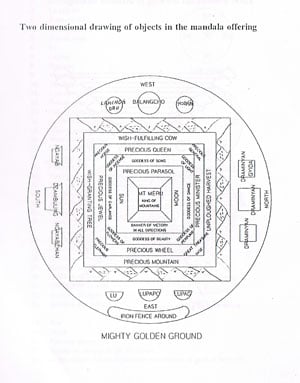
Visualizing the Mandala as a Pure Realm
“Sa.zhi po.kyi…” At the beginning of this part of the offering, the mandala is seen as impure, then it transforms into the pure realm of a buddha. This practice creates much merit and the karma to take rebirth in a pure realm. It also purifies wrong conceptions. Imagine the pure realm that you would like to be reborn in (according to your practice: Tushita if your practice is Ganden Lha Gyäma; Kacho Shing if you’re practicing Vajrayogini, etc.) and visualize that all sentient beings are there, receiving teachings and just about to become enlightened. It is very powerful to imagine your enemies there in the pure realm, receiving teachings. While reciting the prayer, visualize a rain of offerings showering down in that pure land.
In pure lands one isn’t born from parents but from lotus flowers. One doesn’t have physical bodies subject to sickness and old age, but bodies made of light that never experience sickness or aging. Whatever is wished for spontaneously appears. Food and drink are nectar and do not cause attachment to arise. The entire environment is beautifully decorated and filled with wish-granting trees.
There are buddhas and bodhisattvas everywhere. Depending on which pure land one is in, it’s possible to see the particular buddha of that land and receive direct teachings from his holy speech. All the sounds we hear are Dharma teachings. There are bodhisattvas in the aspect of birds flying around whose songs are teachings. The ground is made of lapis lazuli and there are lotus ponds filled with large, beautiful lotus flowers. The air is perfumed with sweet scents. Goddesses in space scatter a rain of flowers. There are also many dakas and dakinis.
It’s also extremely beneficial to multiply the offering, imagining that you are offering many universes. [As explained before: see the Introduction.]
Hold the mandala at your heart and without attachment to the offerings, offer them with devotion. At the end of the prayer imagine that the mandala dissolves into light and absorbs into the heart of the guru-deity. Think that the guru experiences incredible bliss. Then tip the mandala base to dismantle the mandala: towards you if the offering was made in order to receive realizations, and away from you if the offering was made to the merit field. As you do this, light comes from the guru and enters your body, purifying all hindrances and negative karma of body, speech and mind. Then a replica of the guru dissolves into you. Think that you have become one, completely unified, with the guru and have received all his realizations.
Short (Seven-heap) Mandalas
Start by offering one long mandala of 37 heaps, recite the four-line prayer and dismantle the mandala, then begin to construct short mandalas. Each short mandala begins in the same way as the long mandala: pouring grain on the base and wiping the base with your right wrist three times clockwise and three times counter-clockwise (or as many times as you like), to purify and receive blessings. While doing this, recite the prayer of refuge and bodhicitta (sang.gye cho.dang…) once or as many times as you like. Then pour a little grain on the base, place the first ring and pour grain around the inside of the ring, moving in a counter-clockwise direction.
While reciting the four-line prayer (sa.zhi po.kyi…) place grain for the seven heaps:
1. Mt. Meru in the center,
2-5. The four worlds in the east, south, west and north,
6. The sun in the south,
7. The moon in the north.
Holding the mandala at your heart, recite the rest of the prayer, doing the appropriate visualization. Then dismantle the mandala and visualize receiving light and blessings from the guru.
If you wish you can offer a nine-heap mandala, adding another heap in the east for the precious parasol and one in the west for the victory banner. This practice is advised sometimes as it is very auspicious to offer the victory banner.
When counting mandala offerings [as a preliminary practice], you offer only mandalas of seven or nine heaps.
Begin slowly, with twenty-five short mandalas, and build up slowly. When your physical action becomes smooth, concentrate on the visualization. It is important to open up and give everything to the guru, and to feel that you are really receiving your guru’s blessings.
You can eventually do a hundred mandalas in the morning and a hundred at night as a comfortable number, without pushing.
When offering the mandala of seven heaps, it’s best to visualize all thirty-seven features of the long mandala. But if your mind cannot cope with the elaborate visualization, at least imagine clearly and in proper order, the golden ground, iron fence, Mt. Meru, the four worlds, the sun and the moon. It’s also very beneficial to offer objects that symbolize the realizations you wish to achieve, such as a sword, bell or text, or materials you need for your practice. Visualize these in the space above the mandala. This creates the karma for you to quickly gain these realizations and materials.
NOTES
3 Khensur Losang Nyima Rinpoche explained that a bajung pill is made from cow products. There is a substance in the folds of the skin underneath the neck of the cow that has the potential to purify whatever the cow eats, thus the things produced from the cow—milk, butter, excrement, etc.—also have this potential to purify. Also, one can add a dutsi rilbu(nectar pill) to the water used to clean the base. The way to clean the base is as follows: first place your right thumb in the center of the base, dip your right finger in the mixture, then rub that finger around one half of the edge of the base, moving in a clockwise direction. Next, place your right ring finger in the center of the base, dip the thumb in the mixture, then rub the other half of the edge of the base, moving in a counterclockwise direction. [Return to text]
4 According to Khensur Losang Nyima Rinpoche, the part of the arm with which to rub the base is the thickest part of the forearm, below the elbow. [Return to text]
5 According to Khensur Losang Nyima Rinpoche, when offering the mandala when requesting your guru to live long, eg at a long-life puja, place east towards you. [Return to text]
6 According to Pabongka Rinpoche in Liberation in the Palm of Your Hand (p.212) these seven and the great treasure vase float in the space between the continents and Mt. Meru. [Return to text]
7 According to Liberation (p.212) the eight goddesses stand on a ledge around Mt. Meru. [Return to text]
8 According to Geshe Wangchen in Awakening the Mind of Enlightenment (p.68), the parasol is normally placed towards you, and this is to overcome obstacles to your meditation practice—it symbolizes the protection of all buddhas and bodhisattvas. But in order to receive blessings, place the banner in the east.
Four Ways of Offering the Mandala
1. The Outer Mandala
[As described in Chapter Two.]
2. The Inner Mandala
The inner mandala is a powerful remedy to the three poisonous minds of attachment, aversion and ignorance, that cause us to discriminate other beings as friend, enemy and stranger. It involves imagining your body transforming into the mandala and then into a pure realm, as well as offering the objects of your attachment, aversion and ignorance. The prayer “dag.gi chag.dang…” is recited while visualizing this offering. This prayer is a method to counteract attachment and miserliness towards your body, possessions, merits and the environment. It loosens the grip of attachment; suddenly it makes no sense to be attached to things any more. The mind is transformed and feels very peaceful. The way to transform your body into the mandala is as follows:
- Your skin becomes the surface of the golden ground; your blood becomes an ocean of nectar;
- Your flesh becomes beautiful garlands of flowers floating on the ocean of nectar;
- Your stomach becomes Mount Meru;
- Your hands and feet become the four worlds and the upper and lower parts of your arms and legs become the eight sub-worlds; your head becomes a beautiful palace on top of Mt. Meru;
- Your heart becomes a beautiful jewel adorning the top of this palace;
- Your eyes become the sun and moon;
- All your inner organs become wonderful possessions and enjoyments of gods and humans.
Sometimes regret is felt for having given something. This creates the karma of miserliness. True offering should not be like this; instead, you should completely and sincerely give from the depths of your heart. If you sincerely renounce and dedicate whatever you offer without any clinging, you’ll receive the same merit as if you had actually made the material offering.
Each time you recite the six-session prayer you dedicate your body, life and wealth to your guru and then request his help. You should actually give up attachment to these things, but instead you still think of them as yours: “my body, my possessions.” By verbally offering them while still thinking of them as yours, you receive many downfalls.
Visualize many objects of your attachment, aversion and ignorance in the space above Mt. Meru, and offer all this to your gurus. Don’t visualize one object only: for example, if you have attachment for someone, imagine offering many numbers of that person. Think of possessions or certain types of food that you like, imagine them multiplied many times and offer them to your gurus without any sense of loss. By offering the objects of your negative mind you renounce them and thereby cut off your attachment to them. If they are offered sincerely to the guru-buddha, then they become his and no longer yours, so it is not appropriate to feel attachment or aversion for them.
Ordinary beings are pleased by material offerings, but the best offering to make to your guru is your renunciation of the three poisonous minds. Your guru is extremely pleased by this; not for himself, but because he knows that this is the only way you will achieve liberation.
The essential meaning of giving up is not giving up the object, but relinquishing your attachment to it. A renounced mind is the best offering. It’s no use making offerings to your guru unless you completely offer your body, speech and mind. And once you have offered your body, speech, mind and enjoyments to your guru you should never again think of them as “mine” or try to prevent others from using or taking them.
Therefore, when making the inner offering it’s very powerful to think, “As I have offered my body, speech, mind and the objects of my three poisonous minds to my guru, how can I ever again use them for myself? From now on I must use them only according to his wishes. What does he wish? That I become Buddha to enlighten all sentient beings. For that to happen I cannot use these objects to carry out the aims of my negative mind; that would be completely opposite to my guru’s wishes. I would be misusing my guru’s possessions.”
At the end of the prayer of the inner offering, think, “By offering the objects of my three poisonous minds and those of all sentient beings, may those objects and poisons automatically disappear from our minds.” Imagine that the three poisons have dissolved into emptiness. Even the names, “attachment”, “aversion”, and “ignorance” cease to exist.
3. The Secret Mandala
Here, you manifest as a deity and then your own dharmakaya nature manifests as the mandala. The aspect is the universe: the golden ground, Mt. Meru, etc., but its essence is the transcendental wisdom of non-dual bliss and emptiness. You can visualize yourself as the deity in your own pure land and offer that to your gurus.
4. The Suchness Mandala
Recognize that the three circles: yourself, the action of offering and the guru (or subject, action and object), are all merely labeled by mind and do not exist from their own side. So you are offering the empty nature of these three. See that the appearance of a self-existent circle of three is like a mirage or a dream. As the subject, action and object are all merely labeled by mind, it’s like offering a mandala in a dream. This practice cuts the root of samsara.
These four types of mandala offering can be practiced consecutively or simultaneously. To practice them simultaneously, first meditate on emptiness. Then, from the blissful space of non-duality you manifest as the deity. The different parts of your divine body, the nature of which is the dharmakaya, transform into the various features of the mandala. Then recognize that yourself (the deity), the action of offering and the object of the offering (your guru) are unified in non-duality.
Dedication
At the end of every session of offering mandalas, recite the following prayer written by Lama Tsongkhapa:
May none of these merits become the cause of taking pride in understanding, reputation or receiving things.
May these merits only become the cause of attaining enlightenment.
How to Construct a Mandala with Three Rings
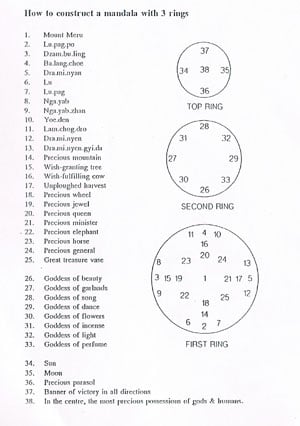
First Ring
1. Mount Meru
2. Lu pag po
3. Dzam bu ling
4. Ba lang choe
5. Dra mi nyan
6. Lu
7. Lu.pag
8. Nga yab
9. Nga yab zhan
10. Yoe den
11. Lam chog dro
12. Dra mi nyen
13. Dra mi nyen gyi da
14. Precious mountain
15. Wish-granting tree
16. Wish-fulfilling cow
17. Unploughed harvest
18. Precious wheel
19. Precious jewel
20. Precious queen
21. Precious minister
22. Precious elephant
23. Precious horse
24. Precious general
25. Great treasure vase
Second Ring
26. Goddess of beauty
27. Goddess of garlands
28. Goddess of song
29. Goddess of dance
30. Goddess of flowers
31. Goddess of incense
32. Goddess of light
33. Goddess of perfume
Third Ring
34. Sun
35. Moon
36. Precious parasol
37. Banner of victory in all directions
38. In the center, the most precious
possessions of gods and humans
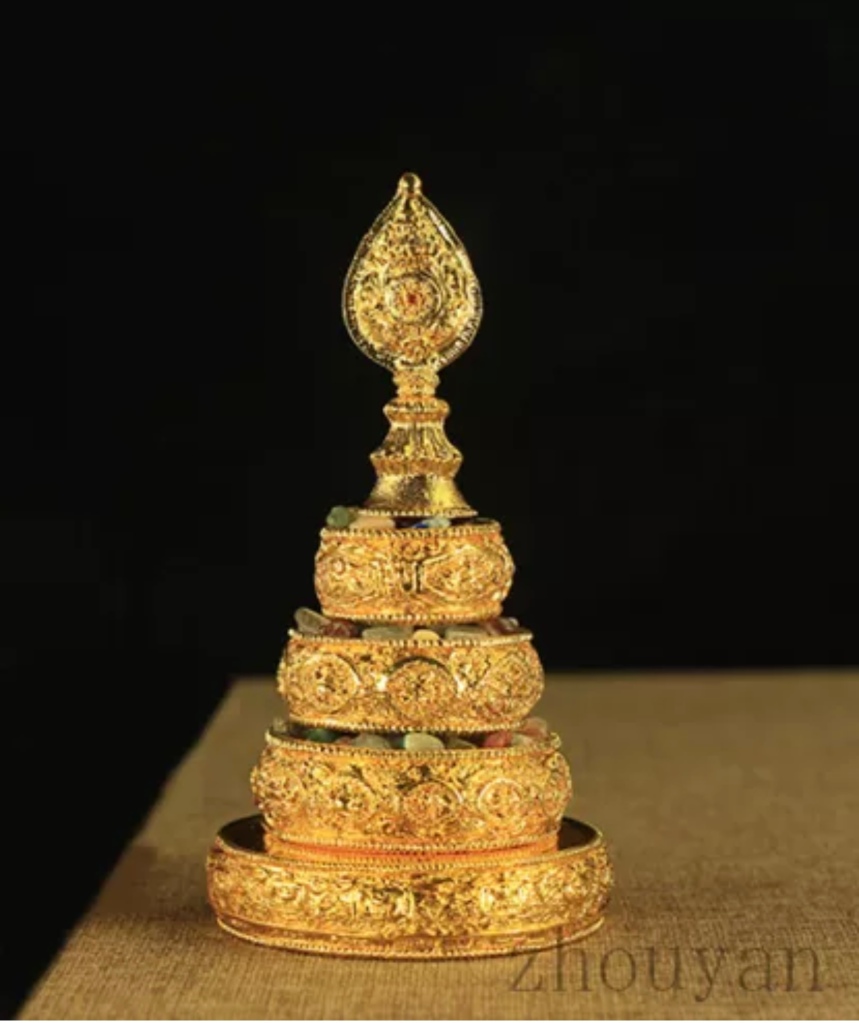
References
- How To Offer A Mandala, By Kyabje Lama Zopa Rinpoche,, Lama Yeshe. Com, https://www.lamayeshe.com/article/how-offer-mandala
